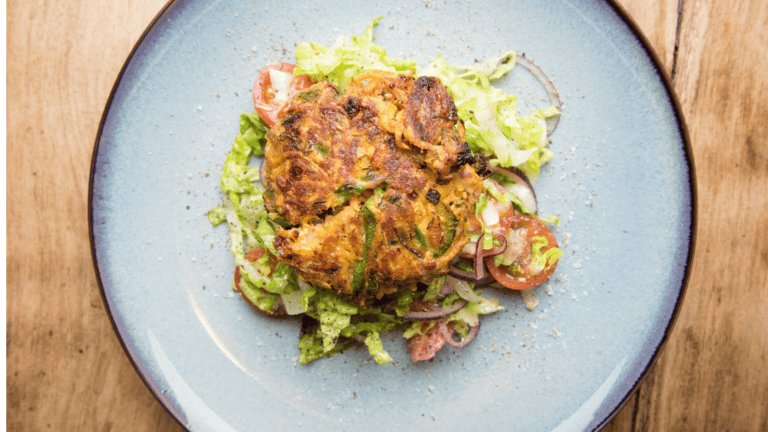Delicious Gujarati Steamed Muthia with Tempered Cabbage
Get ready to tantalize your taste buds with the mouthwatering flavors of Gujarati cuisine. In this article, we bring you a delectable recipe for Delicious Gujarati Steamed Muthia with Tempered Cabbage.
These steamed dumplings, made from cabbage and a medley of aromatic spices, perfectly balanced flavors. Topped with a fragrant tempering of mustard seeds and curry leaves, this dish is a crowd-pleaser that will transport you straight to the heart of Gujarat.
So, let’s dive into the world of Gujarati culinary delights and discover the magic of these delectable muthias!
Delicious Gujarati Steamed Muthia with Tempered Cabbage
If you want to try something new and delicious, you must try Gujarati Steamed Muthia with Tempered Cabbage. This traditional dish from Gujarat, a state in western India, combines the goodness of steamed dumplings with the flavorful tempering of cabbage.
It is a dish that is delicious, healthy, and easy to make. So, let’s dive into Gujarati cuisine and learn how to make this mouthwatering delicacy!
The Origins of Muthia
Muthia is a traditional Gujarati snack rooted in the state’s rich culinary heritage. The name “Muthia” is derived from the Gujarati word “muthi,” which means fist, as the dough is shaped into small cylindrical rolls using the hand.
This snack uses various ingredients like vegetables, flour, and spices, which are then shaped into small dumplings and steamed or fried. Muthia is delicious and a great way to incorporate vegetables into your diet, making it a healthy snack or light meal choice.
The Versatility of Cabbage
Cabbage is one of the most versatile cruciferous vegetables widely used in different cuisines worldwide. It is packed with essential nutrients like vitamin C, K, and fiber, making it a nutritious addition to any dish.
In Gujarati cuisine, cabbage is often tempered with aromatic spices like mustard seeds, cumin seeds, and curry leaves to enhance flavor. When combined with steamed muthia, tempered cabbage adds a delightful crunch and a burst of flavors that complement the dumplings perfectly.
The Art of Steaming
Steaming is a popular cooking method in Indian cuisine, as it helps retain the nutrients and flavors of the ingredients. In the case of muthia, steaming ensures that the dumplings are cooked evenly, resulting in a soft and moist texture.
Steaming involves placing the dough rolls in a steamer and cooking them over boiling water for a specific duration. Steamed muthia are healthier than fried muthia and have a lighter and more delicate taste, allowing the flavors of the spices and vegetables to shine through.
The Magic of Tempering
Tempering, also known as tadka or vaghar, is a technique widely used in Indian cooking to enhance the flavor of a dish. It involves heating oil or ghee and adding spices like mustard seeds, cumin seeds, and curry leaves to release their aromatic flavors. The tempering is then poured over the prepared dish, adding a burst of flavors and a tantalizing aroma. Tempered cabbage, with its blend of spices and crispy texture, elevates the simple muthia to a whole new level of deliciousness.
Ingredients
To make Gujarati Steamed Muthia with Tempered Cabbage, you will need the following ingredients:
Subheading 2.1: For the Muthia
- 1 cup gram flour (besan)
- 1/2 cup wheat flour (optional)
- 1/4 cup semolina (sooji)
- 1 cup finely grated cabbage
- 1/4 cup fresh fenugreek leaves (methi)
- 2 tablespoons yogurt
- 2 tablespoons oil
- 1 tablespoon ginger-garlic paste
- 1 teaspoon turmeric powder
- 1 teaspoon red chili powder
- 1 teaspoon cumin powder
- 1 teaspoon coriander powder
- Salt to taste
For the Tempered Cabbage
- 2 cups finely chopped cabbage
- 2 tablespoons oil or ghee
- 1 teaspoon mustard seeds
- 1 teaspoon cumin seeds
- 1 sprig curry leaves
- 1 teaspoon turmeric powder
- 1 teaspoon red chili powder
- Salt to taste
For the Garnish
- Fresh coriander leaves, chopped
For Serving
- Tomato ketchup or mint chutney (optional)
Kitchen Equipment
- Steamer or large pot with a steaming rack
Preparation
Before cooking, let’s go through the preparation steps for the muthia and tempered cabbage.
Preparation for the Muthia
- In a large mixing bowl, combine the gram flour, wheat flour (if using), semolina, grated cabbage, fenugreek leaves, yogurt, oil, ginger-garlic paste, turmeric powder, red chili powder, cumin powder, coriander powder, and salt.
- Mix everything well to form a soft and pliable dough. Add a little water or yogurt to adjust the consistency if the dough feels too dry.
- Once the dough is ready, divide it into small portions and shape each portion into cylindrical rolls or oblong-shaped dumplings. Make sure to smoothen the surface of the dumplings for even cooking.
Preparation for the Tempered Cabbage
- Heat oil or ghee in a pan or kadai over medium heat.
- Add the mustard seeds and let them crackle.
- Add the cumin seeds and curry leaves and sauté for a few seconds until fragrant.
- Add the finely chopped cabbage and stir-fry for 2-3 minutes until it wilts slightly.
- Sprinkle turmeric powder, red chili powder, and salt over the cabbage, and mix well.
- Cook the tempered cabbage for 5-7 minutes until it is tender yet retains a slight crunch.
Steam Cooking the Muthia
- Fill a steamer or a large pot with water and bring it to a boil.
- Place the muthia rolls on a steaming rack or a plate in the steamer, leaving some space between them for even cooking.
- Cover the steamer tightly and steam the muthia for approximately 15-20 minutes or until cooked. You can check the doneness by inserting a toothpick or a knife into the muthia – if it comes out clean, they are ready.
- Once cooked, remove the muthia from the steamer and let them cool for a few minutes.
Cooking Method
Now that the preparation is done, let’s move on to the cooking method for Gujarati Steamed Muthia with Tempered Cabbage.
Cooking the Muthia
- Heat a frying pan or tawa over medium heat and add a little oil.
- Place the steamed muthia on the hot pan and shallow fry them until they turn golden brown on all sides. This step is optional, as the muthia can be enjoyed without frying as well. Frying gives them a crispier texture and adds an extra layer of flavor.
- Once the muthia are cooked to your desired level of crispness, remove them from the pan and set them aside.
Tempering the Cabbage
- In the same pan used for frying the muthia, heat oil or ghee over medium heat.
- Add mustard seeds and let them crackle.
- Add cumin seeds and curry leaves, and sauté for a few seconds until fragrant.
- Add the cooked tempered cabbage to the tempering mixture, and mix well to coat the cabbage evenly.
- Cook the tempered cabbage for another 2-3 minutes, stirring occasionally, until the flavors are well combined.
Serving
Now that both the muthia and tempered cabbage are ready, it’s time to bring all the delicious flavors together and serve the dish.
Assembly
- Place the fried muthia on a serving plate, arranging them neatly.
- Spoon the tempered cabbage over the muthia, covering them generously.
- Garnish with freshly chopped coriander leaves.
Optional Accompaniments
If you prefer, you can serve Gujarati Steamed Muthia with Tempered Cabbage with tomato ketchup or mint chutney on the side. These condiments add a tangy and refreshing element to the dish, balancing the flavors and satisfying your taste buds even more.
Congratulations! You have successfully prepared Gujarati Steamed Muthia with Tempered Cabbage, a delicious and healthy dish that showcases the flavors of Gujarat. The soft and flavorful muthia, paired with the aromatic and crunchy tempered cabbage, create a culinary experience that will leave your taste buds craving for more.
Whether you enjoy it as a snack, a light meal, or as a part of a Gujarati thali (traditional Indian platter), this dish is sure to impress. So, gather the ingredients, follow the steps, and indulge in the savory flavors of Gujarati cuisine!

Born and raised in a family of foodies, Georgia’s passion for cuisine was nurtured from a young age as she learned the intricacies of flavor and texture from her grandmother’s kitchen. As an adult, this early fascination blossomed into a full-fledged love affair with the culinary world.








